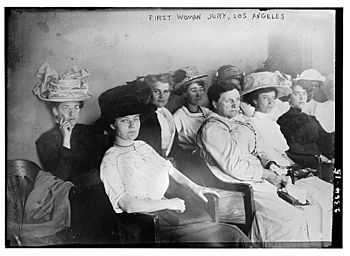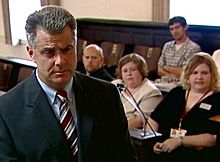Voir dire facts for kids
Voir dire is a name for the process of choosing jurors for a trial. It can also mean a small meeting between lawyers and a judge during a trial. It originally referred to an oath taken by jurors to tell the truth (Latin: verum dicere). In the modern court systems, voir dire is a process governed by state and federal laws. It is basically designed to find biases in jurors. It has other uses depending on the court system.
Contents
History of voir dire
The origin of the legal term voir dire is Anglo-Norman. It was an oath given to members of a jury. Witnesses are usually sworn in with the oath: "The evidence you shall give... shall be the truth, the whole truth, and nothing but the truth...". The voir dire oath was: "you shall true answer make to all such questions the court shall demand of you..." In the United States the history of voir dire goes back to the Massachusetts Jury Selection Law of 1760. Many cases that went to trial involved seditious libel. British officials in the colonies put anyone on trial who printed anything criticizing British rule. To get every conviction possible, the British government made sure to only pick jurors who would convict the defendant. The sheriff was made responsible to select a list of jurors favorable to the British crown. To counter this, the 1760 Massachusetts law required the list the sheriff used to be selected by a town meeting. In those public meetings prospective jurors were questioned about any biases they might have. Defendants were also able to question possible jurors before they were selected. This voir dire process made jury selection fair. In 1774 the British Parliament cancelled the 1760 Massachusetts law. They left jury selection up to the court. This gave the crown a free hand in making sure trials ended the way they wanted. But, two years later the Americans declared their independence. The American system of voir dire was developed from that time on.
Use in jury selection (United States)
Voir dire is an opportunity for lawyers to get the best juries for their client. This can become very involved. The process begins as the potential jurors enter the courtroom. The lawyers or their paralegals study the jury panel. They watch body language. They watch who jurors talk to or sit next to. There is a great deal of psychology used in jury selections. Juror behavior can be as important as their answers to questions. The voir dire questions are designed to reveal how a potential juror thinks. For example, books potential jurors read can reveal how they might vote. Also, lawyers try to give each juror individual attention while their paralegal takes notes. Eye contact, body language and attitude are all carefully studied during the interview.
In the United States voir dire is used to eliminate jurors who may have been influenced by pretrial publicity. But there are some indications it may do just the opposite if jurors are asked what their opinions are as to what the outcome should be. Outside the United States pretrial publicity is handled differently. Judges can order individuals not to talk about the trial while it is in progress. This is the case in Australia and Canada.
Judges have a great deal of discretion (choices) in the voir dire process. In some courts the judge conducts voir dire. In other situations it is left entirely to the lawyers. In some cases it is a combination of both. Jurors are usually not quite as honest in answering voir dire questions with a judge as they are with a lawyer.
Use with expert witnesses
In some courts lawyers are given the chance to interview expert witnesses before they testify. An expert witness is anyone who has specialized or expert knowledge of a subject more than an average person would have. Sometimes an expert can be interrupted in his or her testimony for a voir dire to challenge their expertise. If a judge feels the challenge was successful, he can tell the jury to ignore the testimony.
Use with evidence
In the United Kingdom voir dire is not used for jury selection. It is used to decide what evidence can and cannot be presented during the trial. This can include confessions made to the police. In Australia and Canada, voir dire is used as a sub-trial within a trial to examine evidence. It is usually done with the jury absent from the courtroom. In Canada, voir dire can also be used to challenge a particular juror for cause (for a specific reason). But cases of challenging a juror under voir dire are rare in Canada.
See also
 In Spanish: Voir dire para niños
In Spanish: Voir dire para niños




